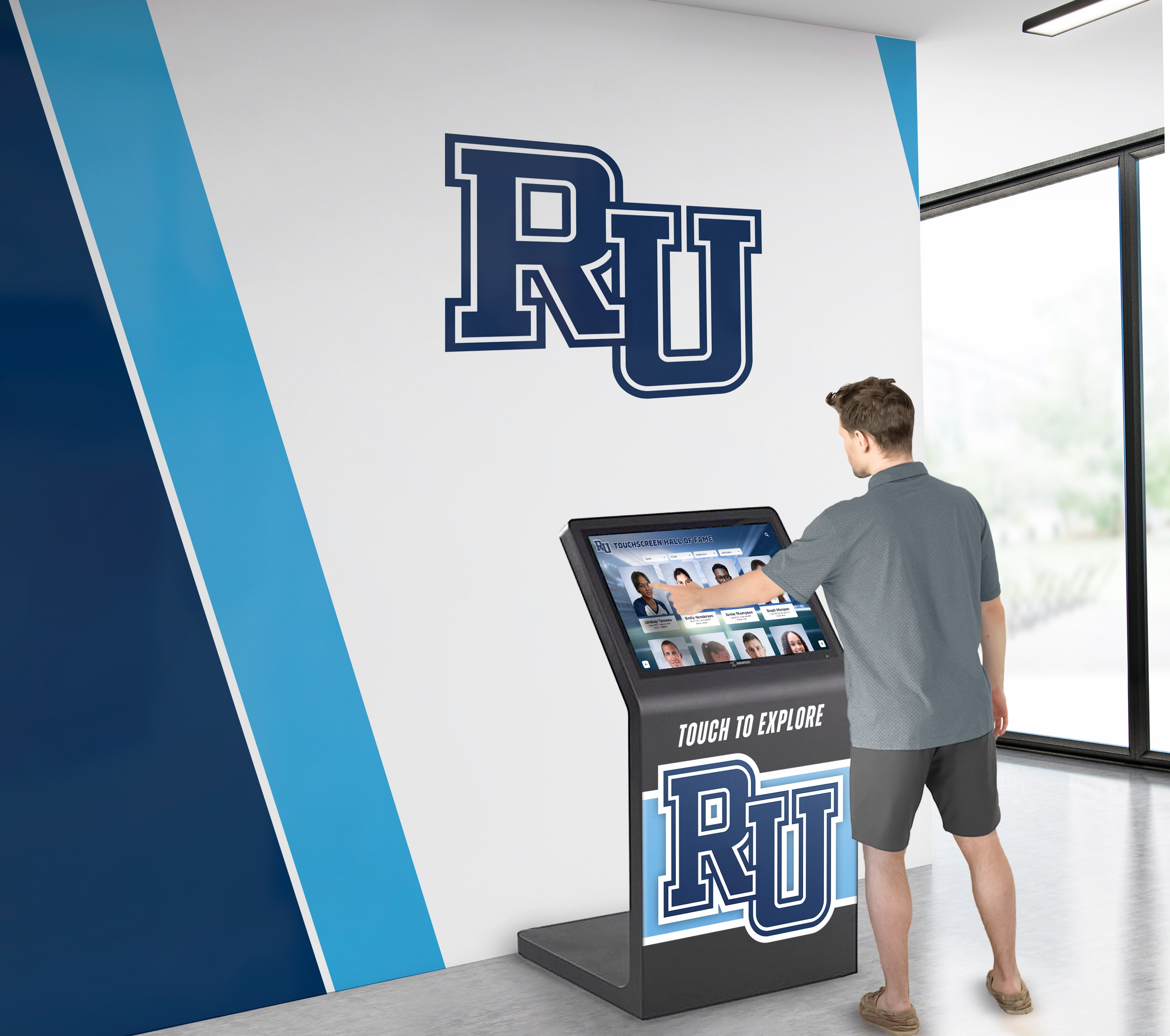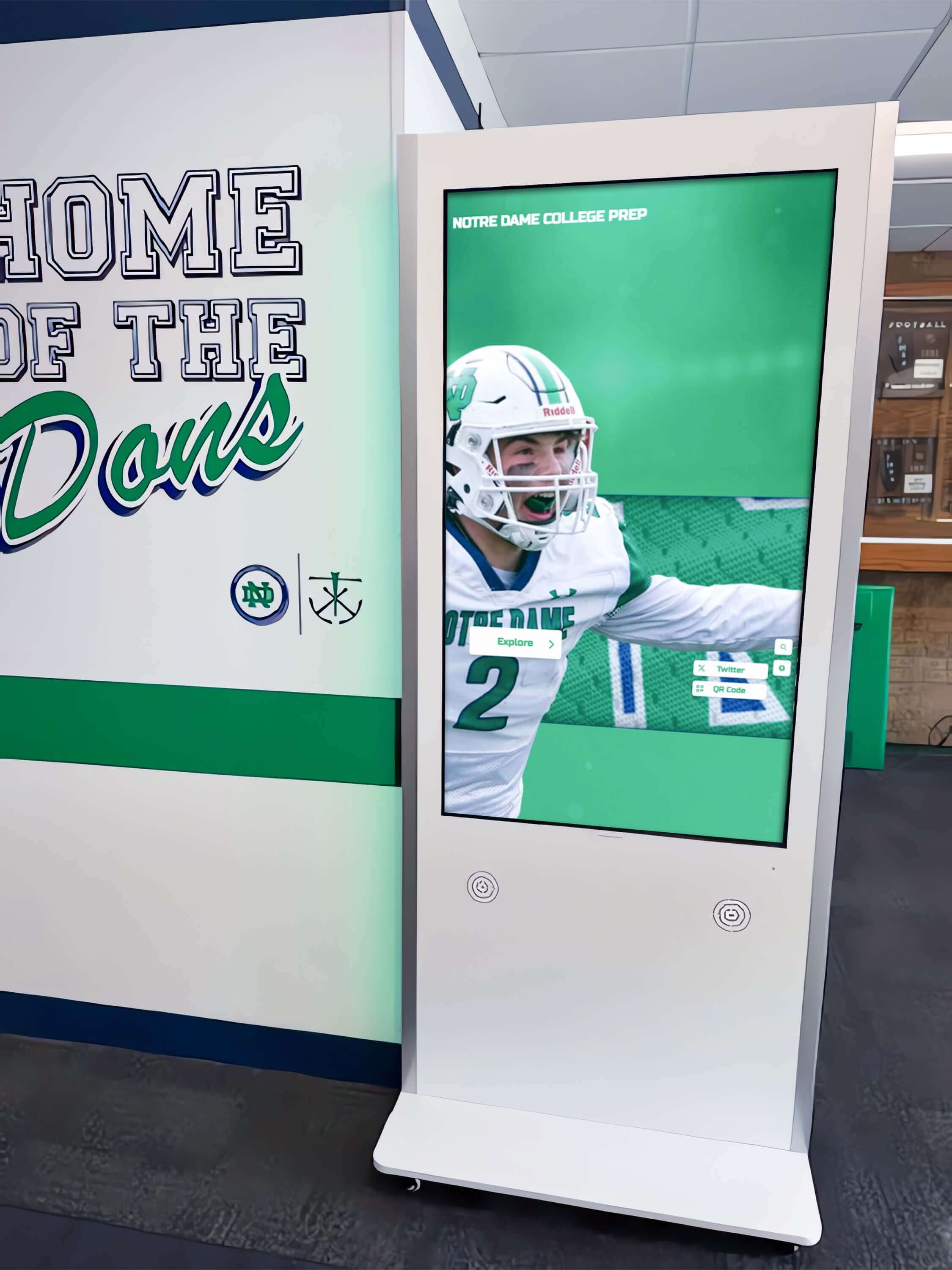Key Takeaways
Comprehensive guide to digital hall of fame software and digital signage for schools, museums, and organizations. Compare platforms, features, implementation strategies, and best practices for 2025.
Understanding Digital Hall of Fame Software and Digital Signage
Before diving into specific platforms and implementation strategies, it’s essential to understand what these technologies are and how they differ from generic digital displays.
What Is Digital Hall of Fame Software?
Digital hall of fame software refers to specialized platforms designed specifically for creating interactive recognition displays that celebrate achievements, preserve institutional histories, and showcase honorees through searchable databases, multimedia profiles, and engaging user interfaces. Unlike generic content management systems or basic slideshow applications, purpose-built hall of fame software includes features specifically designed for recognition applications:
- Searchable Profile Databases: Allow visitors to quickly find specific individuals, teams, achievements, or time periods through intuitive search interfaces
- Rich Multimedia Support: Enable comprehensive storytelling through high-resolution photos, video highlights, biographical narratives, statistical data, and historical context
- Flexible Organization Systems: Provide categorization tools matching how institutions naturally organize recognition (by sport, academic discipline, year, achievement type, etc.)
- Timeline and Historical Views: Display achievement progression, program evolution, and era comparisons helping visitors understand context
- Content Management Tools: Offer administrative interfaces designed for non-technical staff to add honorees, update information, and manage content easily
Solutions like Rocket Alumni Solutions represent purpose-built platforms specifically designed for educational institutions, museums, and organizations implementing digital recognition displays—delivering capabilities that generic alternatives struggle to match.
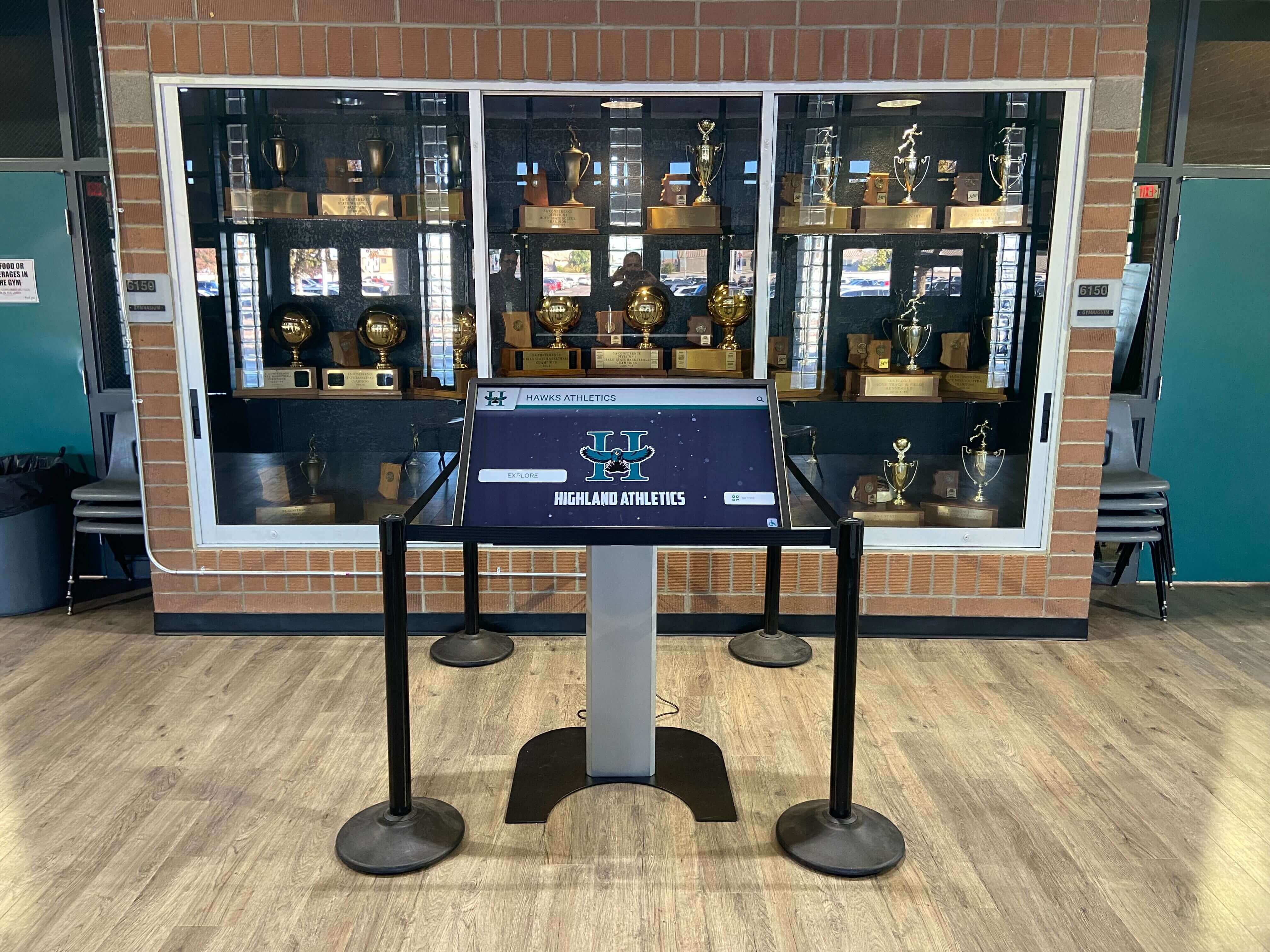
Digital Signage vs. Digital Hall of Fame Software
While the terms are sometimes used interchangeably, digital signage and digital hall of fame software serve different primary purposes:
Digital Signage typically refers to display systems designed for broadcasting information, announcements, advertisements, wayfinding, or general communications to audiences. Digital signage excels at:
- Displaying announcements, schedules, and event information
- Showing cafeteria menus and daily updates
- Providing wayfinding and campus maps
- Broadcasting emergency notifications
- Promoting upcoming activities and programs
Digital Hall of Fame Software specifically focuses on interactive recognition displays enabling visitor exploration through searchable databases and detailed profiles. This specialized software excels at:
- Honoring individual and team achievements comprehensively
- Creating engaging multimedia storytelling experiences
- Enabling visitor-driven exploration and discovery
- Preserving and contextualizing institutional histories
- Building pride and inspiration through recognition
Many modern recognition displays combine both approaches—using interactive hall of fame software for core recognition content while incorporating digital signage elements for announcements, event promotion, and current information display.
Why Schools and Organizations Are Adopting Digital Recognition Technology
The rapid adoption of digital hall of fame software and recognition displays stems from compelling advantages these systems deliver over traditional static displays.
Unlimited Recognition Capacity
Traditional trophy cases and plaque walls face severe space limitations forcing institutions to make difficult choices about what achievements receive recognition. According to industry data, the typical high school athletic trophy case holds only 30-50 trophies maximum before reaching capacity. Digital systems eliminate this constraint entirely.
A single 55-inch touchscreen display can showcase thousands of achievements with detailed information that would require dozens of physical trophy cases to approach. Every championship, every record, every honoree receives appropriate celebration without space compromises. Schools implementing digital recognition report displaying 5-10 times more achievements than previous physical displays allowed.
Dynamic Content Updates
Traditional recognition displays require significant time and expense to update. Adding new plaques involves ordering materials, coordinating engraving, scheduling installation labor, and often rearranging existing items to accommodate additions. These barriers mean recognition often lags months behind achievements or updates get postponed indefinitely.
Digital systems enable content updates in minutes through cloud-based management interfaces. Athletic directors can add new record holders immediately after competitions. Museums can update exhibit information in real-time. Alumni coordinators can publish new inductee profiles the same day as ceremonies. This immediacy ensures recognition stays current and relevant.
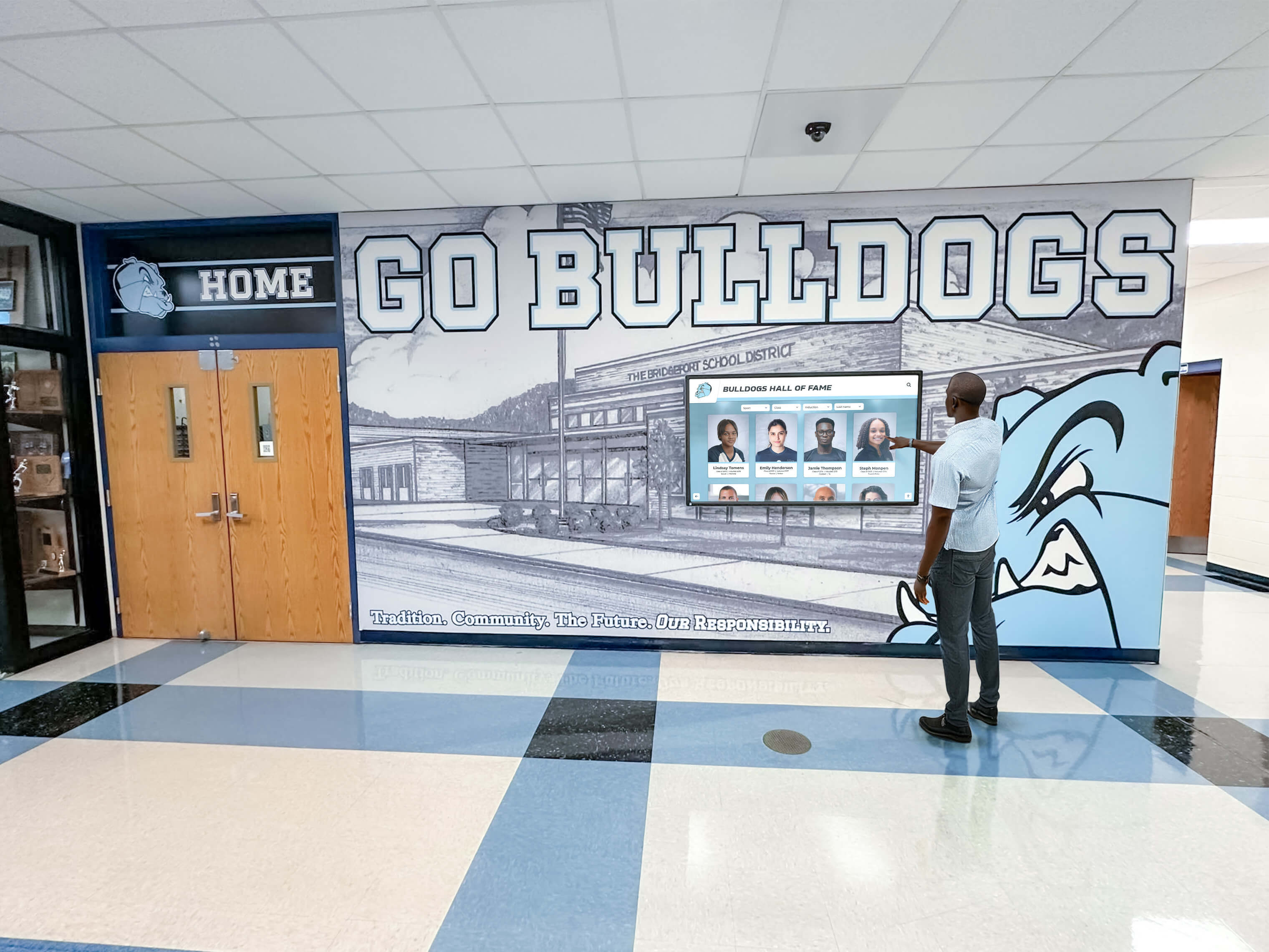
Engaging Interactive Experiences
Static displays offer only passive viewing—visitors glance briefly and move on. Interactive touchscreen systems transform recognition into engaging exploration experiences where visitors actively discover content matching their interests.
Studies indicate digital signage captures 400% more views than static displays, with retention rates for digitally displayed information exceeding traditional print by significant margins. According to research, 96% of students notice digital signage immediately and can recall its content, compared to much lower engagement with paper announcements and static displays.
Interactive features creating this engagement include:
- Powerful Search: Find specific athletes, students, alumni, or achievements quickly
- Smart Filtering: Browse by decade, category, achievement level, or organization
- Connected Content: Explore related achievements, team rosters, and historical context
- Social Sharing: Share discoveries via email, social media, or QR codes enabling mobile access
- Discovery Tools: Featured content, “related profiles,” and browsing suggestions encourage exploration
Operational Efficiency and Cost Savings
While digital recognition requires upfront investment, these systems deliver substantial long-term operational benefits:
Traditional Recognition Costs:
- New trophies and plaques: $150-500 each
- Engraving services: $30-75 per item
- Installation labor: $50-150 per update
- Case maintenance and repairs: $500-2,000 annually
- Additional cases as space fills: $3,000-8,000 each
Digital Recognition Benefits:
- Content updates in minutes, not days
- Zero materials costs for new achievements
- Minimal maintenance beyond screen cleaning
- Unlimited capacity eliminating space constraints
- Professional appearance maintained automatically
Most schools implementing digital recognition achieve return on investment within 3-5 years through elimination of recurring update costs while gaining enhanced recognition capabilities traditional displays can never provide.
Enhanced Accessibility and Reach
Traditional trophy cases present accessibility challenges for wheelchair users unable to view top shelves, visually impaired visitors struggling to read small plaques through glass, and alumni living far from campus unable to visit physical displays. Digital recognition addresses these limitations comprehensively.
Touchscreen interfaces can be mounted at wheelchair-accessible heights with adjustable text sizing for reduced vision. Content management systems ensure proper accessibility markup enabling screen reader compatibility. Most importantly, web-based companion applications extend recognition beyond physical locations—alumni anywhere globally can explore achievements, share profiles, and maintain connections with their institutions.
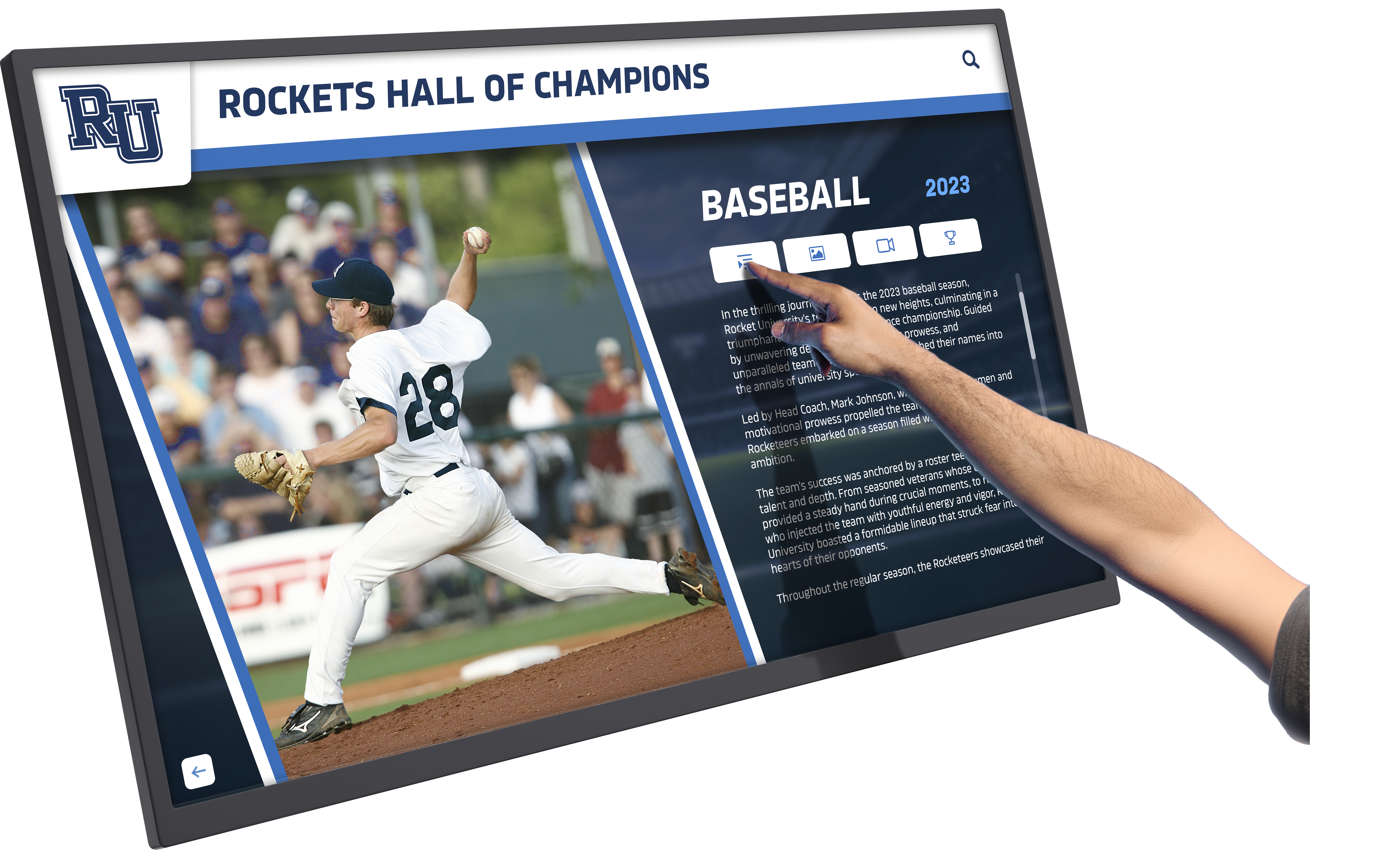
Essential Features of Effective Digital Hall of Fame Software
Organizations evaluating digital recognition platforms should prioritize specific capabilities distinguishing professional solutions from consumer applications repurposed for institutional use.
Intuitive Content Management
The administrative experience determines whether recognition content stays current or becomes stale due to update difficulties. Effective platforms provide:
Visual Content Editors: Non-technical staff should add achievements, upload media, and publish updates without programming knowledge or IT department assistance for every change.
Template-Based Consistency: Pre-designed layouts ensure professional presentation across all profiles while incorporating institutional branding automatically without requiring design expertise.
Bulk Import Capabilities: Recognition displays often include extensive historical content requiring efficient batch processes accepting spreadsheets or data exports from existing systems rather than manual individual entry.
Workflow Management: Approval processes, draft modes, and version control appropriate for environments where multiple stakeholders review content ensuring accuracy before publication.
For schools exploring comprehensive touchscreen software options, content management simplicity determines whether staff actively maintain current information or allow displays to become outdated.
Rich Multimedia Capabilities
Celebrating achievements effectively requires diverse media types creating engaging storytelling experiences:
High-Resolution Photography: Support for large image files displayed beautifully on modern high-resolution displays with proper aspect ratio handling and zoom capabilities.
Video Integration: Seamless playback of championship highlights, record-breaking performances, ceremony footage, and interview content without requiring separate video players or complex encoding.
Audio Narration: Optional audio descriptions, interviews, or historical commentary enhancing accessibility while enriching content for visitors who learn best through auditory information.
Document Display: Ability to showcase historical documents, newspaper clippings, certificates, programs, and archival materials providing rich historical context.
Statistical Data: For athletic recognition, robust support for displaying statistics, records, progressions, and comparative data helping visitors understand achievement significance.
Powerful Search and Navigation
Visitors should find content matching their interests quickly through intuitive interfaces requiring no instruction:
Natural Language Search: Allow users to search using conversational queries rather than requiring exact name spelling or specific keywords.
Faceted Filtering: Enable simultaneous filtering by multiple dimensions—sport AND decade AND achievement type—narrowing large databases to relevant results efficiently.
Smart Suggestions: As users type search terms, suggest matching profiles, categories, and content preventing failed searches from misspellings or uncertainty about exact names.
Related Content Discovery: After viewing one profile, surface related achievements, team members, similar accomplishments, or historical context encouraging continued exploration.
Persistent Navigation: Provide clear orientation showing where users are within content hierarchies with obvious pathways returning to home screens or previous pages preventing disorientation.
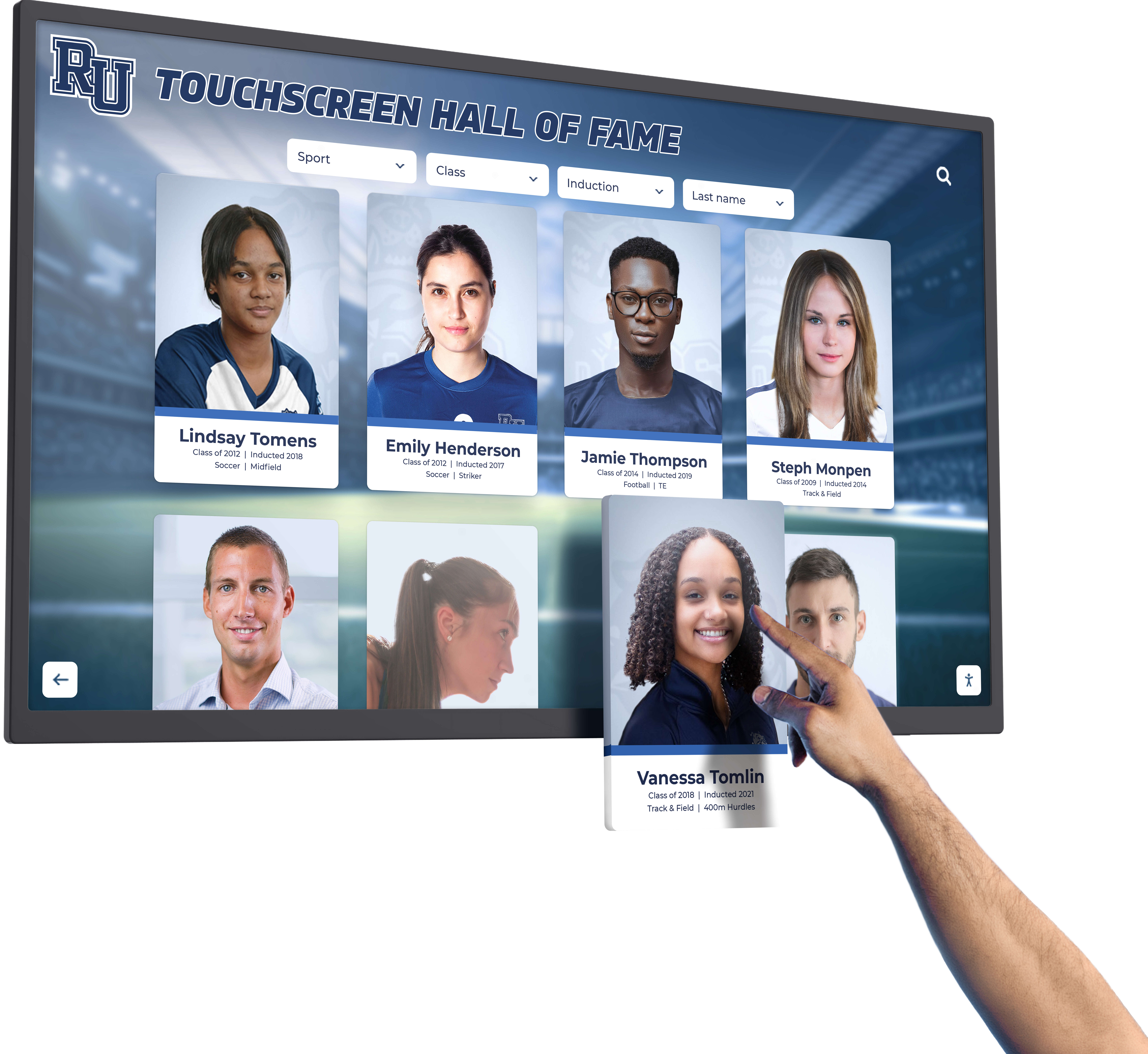
Robust Security and Reliability
Public-facing kiosks require protection against unauthorized access, misuse, and security vulnerabilities:
Application Lockdown: Prevent users from accessing underlying operating systems, launching unauthorized applications, or escaping intended kiosk interfaces through key combinations or gestures.
Secure Content Management: Administrative interfaces protected by authentication, role-based access controls, and encrypted communications ensuring only authorized staff modify content.
Automatic Session Management: After periods of inactivity, automatically return to home screens clearing all session data ensuring subsequent users cannot access information from previous interactions.
Remote Monitoring: Cloud-based management platforms enabling administrators to monitor device health, verify uptime, deploy updates, and troubleshoot issues without physical access to equipment.
Commercial-Grade Hardware: Support for displays and computers designed for continuous public operation rather than consumer devices lacking durability specifications institutional deployments require.
Analytics and Measurement
Understanding how visitors engage with recognition displays validates investments and informs content optimization:
Interaction Tracking: Monitor which content receives most views, how long visitors explore specific profiles, what search terms people use, and navigation paths through content hierarchies.
Usage Patterns: Identify peak usage times, seasonal variations, event-driven engagement spikes, and long-term trends showing whether interest increases or wanes over time.
Content Performance: Determine which achievement categories generate most engagement, which multimedia elements visitors consume completely, and where users abandon exploration helping optimize future content.
Comparative Analytics: Compare engagement metrics across multiple display locations, benchmark performance against similar institutions, and track improvements resulting from content updates or interface changes.
For detailed guidance on measuring digital recognition success, explore comprehensive frameworks tracking both quantitative metrics and qualitative impact.
Comparing Digital Hall of Fame Software Solutions
Schools and organizations evaluating platforms face numerous options ranging from specialized recognition software to generic kiosk solutions requiring extensive customization.
Purpose-Built Recognition Platforms
Specialized software designed explicitly for halls of fame, recognition displays, and achievement celebration offers substantial advantages over generic alternatives:
Rocket Alumni Solutions represents the leading purpose-built platform specifically designed for educational institutions, museums, and organizations implementing digital recognition. Key advantages include:
- Recognition-Specific Features: Built-in support for athlete profiles, team rosters, achievement categories, statistical records, and timeline views without requiring custom development
- Intuitive Administration: Content management interfaces designed for athletic directors, librarians, and alumni coordinators rather than web developers
- Comprehensive Support: White-glove implementation assistance, content migration services, staff training, and ongoing technical support from recognition experts
- Mobile Integration: Web-based companion applications extending recognition beyond physical displays to smartphones and home computers globally
- Proven Track Record: Over 700 installations across schools, universities, museums, and organizations validating platform effectiveness
For institutions prioritizing recognition displays, purpose-built platforms deliver faster implementation, simpler management, and superior user experiences compared to generic solutions requiring extensive configuration.
Generic Kiosk Software Platforms
General-purpose kiosk platforms designed for diverse business applications can support recognition displays but require more customization effort:
Advantages: Lower initial licensing costs, broader feature sets supporting multiple use cases, established vendor ecosystems, extensive third-party integrations.
Limitations: Lack recognition-specific features requiring custom development, complex administrative interfaces overwhelming non-technical staff, generic user experiences inferior to purpose-built alternatives, limited educational institution expertise from support teams.
Organizations with significant technical resources and unique requirements generic solutions serve well may find these platforms viable. However, institutions seeking turnkey recognition solutions typically achieve better results with specialized software designed specifically for their use cases.
For comprehensive comparisons of interactive kiosk software solutions, evaluate platforms across content management simplicity, feature alignment with institutional needs, total cost of ownership, and vendor expertise serving similar organizations.
Content Management System (CMS) Approaches
Some organizations attempt using website CMS platforms like WordPress, Drupal, or custom web applications for recognition displays. While technically feasible, this approach presents significant challenges:
Technical Complexity: Requires web development expertise, database design, hosting infrastructure management, and ongoing maintenance typical institutional staff lack.
Security Concerns: Web CMS platforms designed for authenticated users on secure devices require extensive hardening for public kiosk environments preventing unauthorized access.
Limited Offline Functionality: Internet-dependent web applications fail during network outages unlike dedicated kiosk software with local content caching and offline operation.
Maintenance Burden: Requires ongoing security updates, plugin compatibility management, backup processes, and technical troubleshooting expertise straining limited IT resources.
While custom development provides maximum flexibility, most institutions achieve superior results with commercial platforms offering comprehensive capabilities, professional support, and proven reliability at lower total costs than custom development alternatives.
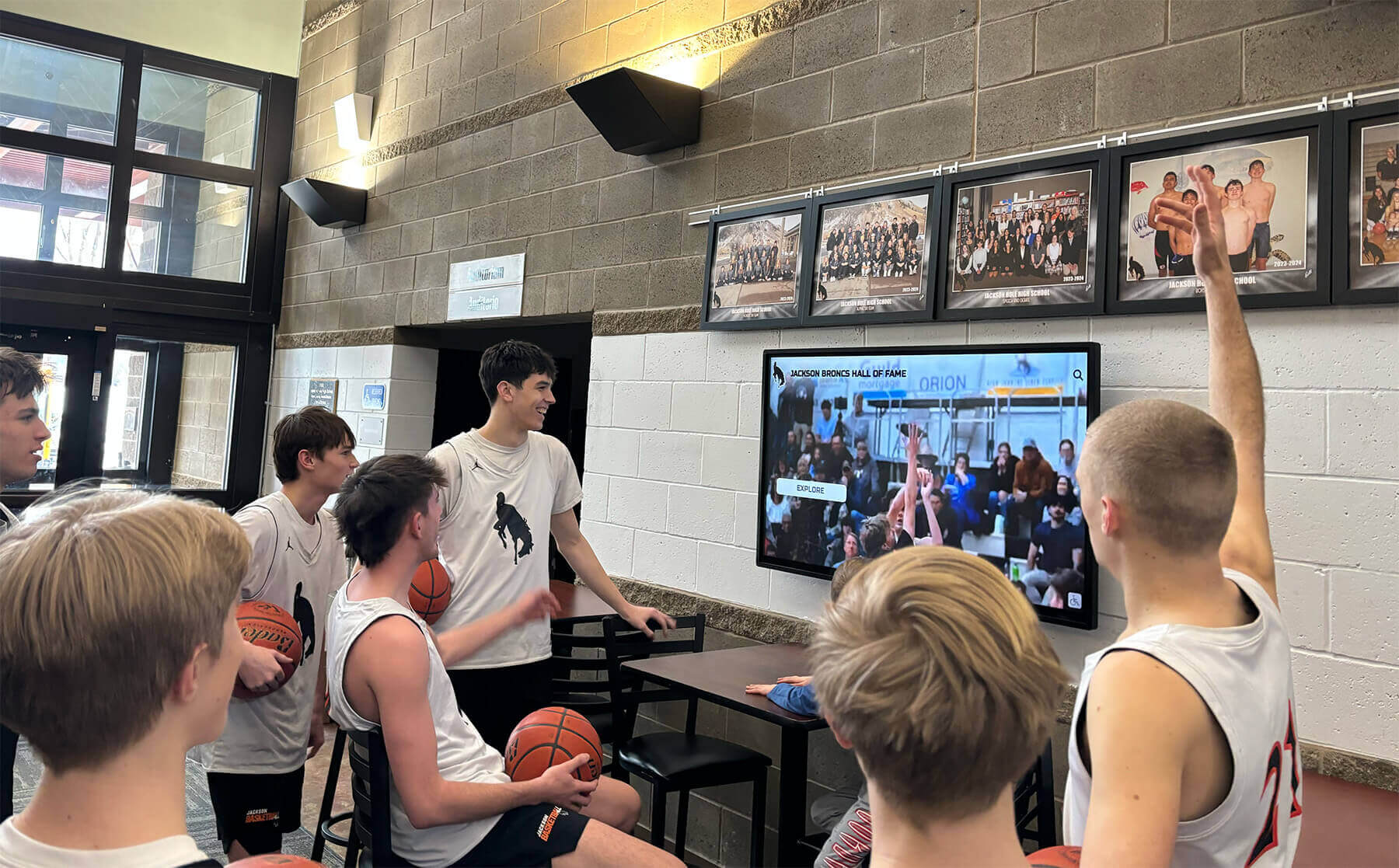
Implementation Best Practices for Digital Recognition Success
Effective digital hall of fame implementations require systematic approaches addressing technical configuration, content development, user experience optimization, and ongoing management.
Strategic Planning Phase
Successful projects begin well before hardware procurement through comprehensive planning establishing clear objectives and realistic scopes:
Define Specific Goals: What should recognition displays accomplish? Build school pride? Engage alumni? Motivate current students? Preserve institutional history? Clear objectives guide appropriate solution selection and success measurement.
Assess Available Resources: Evaluate staff time available for content management, technical expertise supporting systems, budget allocations covering initial investment and ongoing costs, and existing content requiring digitization.
Engage Key Stakeholders: Form planning committees representing diverse perspectives including administrators, content owners, IT staff, facilities managers, accessibility coordinators, and intended user representatives. Cross-functional planning prevents overlooking critical requirements.
Develop Realistic Timelines: Account for vendor selection, content development, hardware procurement, installation scheduling, staff training, and phased rollout approaches. Rushed implementations compromise quality while realistic timelines ensure thorough execution.
Establish Success Metrics: Define measurable indicators demonstrating implementation value such as daily interaction counts, user satisfaction scores, content update frequency, administrative time savings, or visitor survey responses.
Content Development Strategy
Content quality determines whether recognition displays deliver genuine value or become underutilized due to incomplete, outdated, or poorly organized information:
Content Inventory: Catalog existing materials suitable for display including trophy photos, team rosters, historical documents, statistical records, newspaper clippings, and institutional archives. Identify gaps requiring creation or acquisition.
Prioritization Framework: Given finite content development resources, prioritize what gets digitized first—recent achievements generating immediate interest, historically significant content establishing credibility, or high-demand categories generating most engagement.
Information Architecture: Organize content using structures reflecting how visitors think about achievements rather than institutional organizational charts. User-centered architectures employ intuitive categorization and navigation patterns matching mental models audiences bring to interactions.
Content Standards: Establish quality requirements for text, images, videos, and biographical information ensuring professional presentation and institutional voice consistency. Standards address resolution requirements, writing style, factual verification, and approval processes.
Sustainable Workflows: Design content management processes reflecting available staff time and expertise. Unsustainable approaches requiring excessive effort result in stale content undermining recognition value. Successful implementations match management complexity to organizational capacity.
Technical Infrastructure Considerations
Digital recognition systems require adequate infrastructure supporting reliable operation and positive user experiences:
Network Connectivity: Displays need consistent internet access for cloud-based management, sufficient bandwidth for multimedia content delivery, and network security policies enabling appropriate access while protecting institutional systems.
Power and Mounting: Professional installation includes proper electrical work meeting building codes, commercial-grade mounting hardware appropriate for display weight, optimal viewing angles and heights for intended audiences, and adequate ventilation preventing display overheating.
Display Selection: Choose commercial-grade touchscreen displays designed for continuous public operation rather than consumer televisions lacking durability specifications. Consider screen size appropriate for viewing distances, resolution supporting high-quality media, and brightness adequate for ambient lighting conditions.
Physical Security: Install kiosks using tamper-resistant enclosures, locked equipment access panels, cable management preventing disconnection, and mounting preventing theft. Physical security complements software protections preventing unauthorized hardware access.
Accessibility Compliance: Ensure displays meet ADA requirements including appropriate mounting heights enabling wheelchair access, adequate color contrast for reduced vision, compatibility with assistive technologies, and clear physical paths allowing approach from multiple angles.
For comprehensive guidance on technical considerations for educational displays, explore hardware selection, installation best practices, and infrastructure requirements specific to school environments.
Training and Change Management
Technology adoption succeeds when staff feel confident using new systems and understand how they support institutional goals:
Administrator Training: Provide comprehensive instruction for staff responsible for content management covering platform basics, media upload procedures, content organization, scheduling features, and basic troubleshooting. Effective training combines formal instruction, hands-on practice, and ongoing support.
User Orientation: While intuitive interfaces require minimal instruction, some audiences benefit from brief orientation explaining basic navigation, search capabilities, and feature highlights. Consider orientation materials, brief instructional videos, or on-screen prompts guiding first-time users.
Documentation Resources: Create administrator guides, troubleshooting references, vendor contact information, and FAQ documents enabling staff unfamiliar with original implementation to manage systems effectively as personnel changes occur.
Ongoing Support: Establish clear support processes including vendor technical assistance, internal help desk procedures, escalation pathways for critical issues, and regular check-ins addressing emerging questions ensuring staff never feel abandoned with unfamiliar technology.
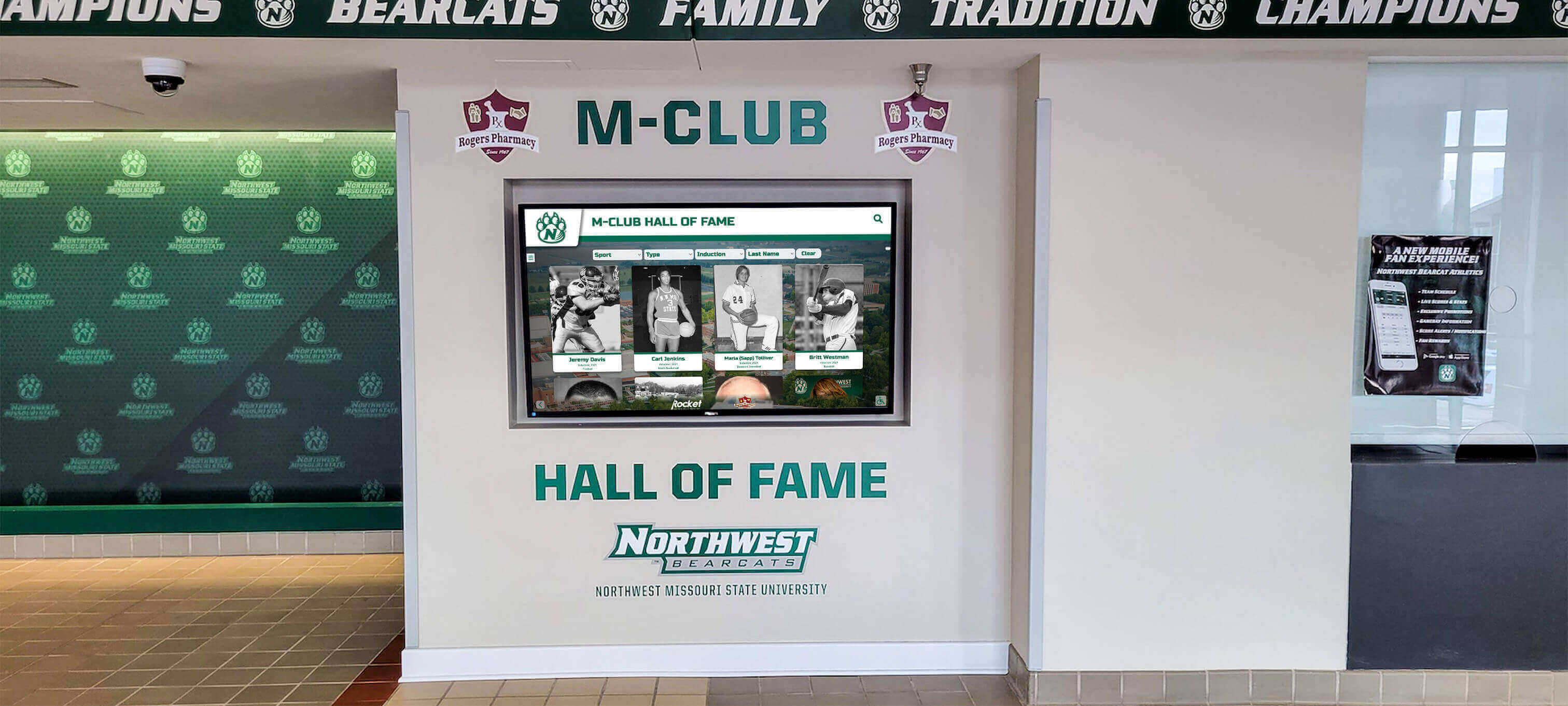
Diverse Applications Across Organizations
Digital hall of fame software and recognition signage support varied use cases across educational, cultural, and community organizations.
Educational Institution Applications
Schools, colleges, and universities implement digital recognition serving multiple institutional priorities:
Athletic Achievement Celebration: Interactive displays showcasing championship teams, record holders, all-conference athletes, coaching legacies, and program histories build athletic pride while motivating current student-athletes through visible recognition. For comprehensive guidance on athletic digital record boards, explore sport-specific features and best practices.
Academic Excellence Recognition: Digital honor rolls, scholarship recipient profiles, academic competition winners, National Merit scholars, and valedictorian achievements receive appropriate celebration without space limitations constraining recognition scope.
Alumni Engagement: Searchable alumni databases, career achievement profiles, distinguished graduate features, and “where are they now” updates strengthen connections between institutions and former students while inspiring current students through successful role models.
Arts and Activities Showcase: Theater productions, musical performances, debate championships, robotics competitions, and club achievements gain visibility equal to traditional athletic recognition demonstrating institutional values celebrating diverse excellence.
Historical Preservation: Digital archives preserve institutional histories through vintage photos, historical documents, facility evolution timelines, and narrative context helping communities understand their heritage while building pride in institutional legacies.
Museum and Cultural Organization Uses
Museums, historical societies, cultural centers, and galleries leverage digital displays enriching visitor experiences:
Interactive Exhibit Enhancement: Kiosks placed alongside physical artifacts provide detailed contextual information, conservation histories, high-resolution imagery, multimedia content, and interactive timelines physical labels cannot accommodate. Enhanced context increases visitor engagement and learning.
Digital Collection Access: Museums house extensive collections with only small fractions displayed simultaneously. Interactive kiosks provide searchable access to digital archives allowing visitors to explore items in storage, view artifacts from multiple angles, and discover connections between displayed pieces and broader collections.
Donor Recognition: Museums implement digital donor walls acknowledging supporters at various giving levels, sharing impact stories, and celebrating philanthropic partnerships making exhibitions and programs possible while supporting ongoing development efforts.
Multilingual Content Delivery: Cultural institutions serving diverse communities utilize digital systems delivering content in multiple languages without cluttering physical spaces with multilingual labels, expanding accessibility for international visitors and multilingual local populations.
Visitor Guidance: Interactive floor plans, exhibit descriptions, suggested tour routes, accessibility information, and estimated viewing times help visitors plan experiences matching their interests and available time, improving satisfaction while encouraging return visits.
Corporate and Community Recognition
Businesses, non-profits, civic institutions, and community groups deploy recognition-focused displays honoring achievements and building organizational culture:
Employee Recognition Programs: Corporate lobbies feature kiosks showcasing employee achievements, service milestones, awards, performance excellence, and career progression stories. Recognition displays strengthen organizational culture by visibly celebrating employee contributions and reinforcing values.
Community Halls of Fame: Civic organizations implement community halls of fame recognizing outstanding citizens, volunteers, local heroes, and community leaders who make significant contributions to local quality of life, strengthening community identity.
Youth Sports Organizations: Recreational leagues and amateur sports programs utilize touchscreen displays celebrating team championships, individual achievements, records, and program histories building participation pride and motivating continued excellence among young athletes.
Non-Profit Impact Storytelling: Organizations employ interactive displays sharing program outcomes, volunteer contributions, community impact, and organizational evolution engaging stakeholders visiting facilities while supporting fundraising through tangible mission achievement demonstration.
Safety Achievement Recognition: Industrial facilities and public safety organizations recognize safety milestones, zero-incident achievements, training completions, and performance excellence reinforcing safety culture and acknowledging employee diligence through visible recognition programs.
Future Trends Shaping Digital Recognition Technology
Digital hall of fame software and recognition signage continue evolving driven by technological advances, changing user expectations, and expanding application possibilities.
Artificial Intelligence Integration
AI technologies enable increasingly sophisticated recognition experiences adapting to user preferences and delivering personalized content:
Natural Language Search: AI-powered processing allows conversational queries rather than requiring specific keywords. Voice interfaces enable hands-free interaction improving accessibility while supporting users more comfortable speaking than typing.
Personalized Recommendations: Machine learning analyzes usage patterns suggesting relevant content based on current browsing, popular items among similar users, and contextual factors creating more engaging discovery experiences.
Automated Content Enhancement: AI assists content creation through automatic image enhancement, video editing, text summarization, and metadata generation reducing administrative burden while improving content quality and consistency.
Intelligent Analytics: Advanced analytics predict peak usage times, forecast content popularity, identify optimal update schedules, and detect anomalies indicating technical issues before they cause complete failures enabling proactive management.
Enhanced Accessibility Features
Advancing accessibility technologies and increasing emphasis on universal design drive recognition displays toward more inclusive experiences:
Advanced Screen Reader Support: Improved compatibility enables better experiences for blind or low-vision users through optimized content structure, semantic markup, and audio descriptions for visual content.
Gesture and Gaze Control: Alternative input methods including gesture recognition and eye-tracking provide interaction options for users unable to utilize standard touch interfaces due to mobility limitations or physical disabilities.
Real-Time Translation: Automatic translation technologies enable real-time content translation presenting information in users’ preferred languages without requiring manual creation of multiple language versions for all content.
Adaptive Interfaces: Systems automatically adjust based on detected user needs providing larger text for elderly visitors, simplified navigation for users struggling with complex paths, or extended timeouts for users requiring additional time completing tasks.
Cloud Infrastructure and Mobile Integration
Modern architectures leverage cloud computing and mobile connectivity extending recognition beyond physical displays:
Cloud-Based Management: Centralized platforms enable content updates, configuration changes, and software deployments from anywhere with internet access dramatically simplifying administration for distributed installations.
Mobile Companion Applications: Recognition extends beyond kiosks through mobile apps enabling visitors to save favorites, continue exploration on personal devices, receive additional content, and share discoveries via social media. Mobile integration extends engagement beyond kiosk sessions.
Omnichannel Experiences: Visitors starting exploration on websites can seamlessly continue at physical kiosks maintaining preferences and viewing history. Synchronized experiences provide continuity across channels creating cohesive recognition ecosystems.
QR Code Extension: Strategic QR codes enable quick mobile access to specific profiles allowing visitors to capture content for later review without standing at kiosks consuming lengthy multimedia, improving flow and accommodating more simultaneous users.
Conclusion: Transforming Recognition Through Digital Innovation
Digital hall of fame software and interactive digital signage represent transformative technologies fundamentally changing how educational institutions, museums, corporations, and community organizations celebrate achievements, preserve histories, and engage audiences. The advantages over traditional static displays—unlimited capacity, dynamic updates, engaging interactivity, operational efficiency, and enhanced accessibility—deliver compelling value justifying investments while creating recognition experiences impossible with physical plaques and trophy cases.
Organizations successfully implementing digital recognition systems prioritize clear objectives, realistic planning, quality content development, and ongoing management commitment. The distinction between specialized recognition software and generic alternatives significantly impacts long-term success—purpose-built platforms designed specifically for halls of fame deliver superior results through recognition-specific features, intuitive administration, and engaging user experiences generic solutions cannot match without extensive customization.
As technology continues advancing, digital recognition systems will become even more powerful through artificial intelligence, enhanced accessibility, and seamless integration with mobile devices and cloud infrastructure. Organizations implementing these systems now position themselves at the forefront of recognition innovation while delivering immediate benefits transforming how communities celebrate excellence and honor achievement.
Whether implementing athletic halls of fame, academic honor rolls, museum exhibits, corporate recognition programs, or community celebration displays, success begins with selecting software specifically designed for recognition applications rather than adapting generic platforms never intended for specialized requirements. This fundamental platform decision influences every aspect of implementation—from initial deployment through years of ongoing operation—determining whether digital recognition becomes a valued institutional asset or a disappointing technology investment failing to deliver expected value.
Ready to explore how purpose-built digital hall of fame software can transform recognition at your institution? Rocket Alumni Solutions provides comprehensive platforms specifically designed for educational institutions, museums, and organizations—delivering recognition-specific features, white-glove implementation support, and proven results across over 700 installations. Discover how specialized software designed explicitly for celebrating achievements delivers superior value compared to generic alternatives requiring extensive customization while producing inferior results.
